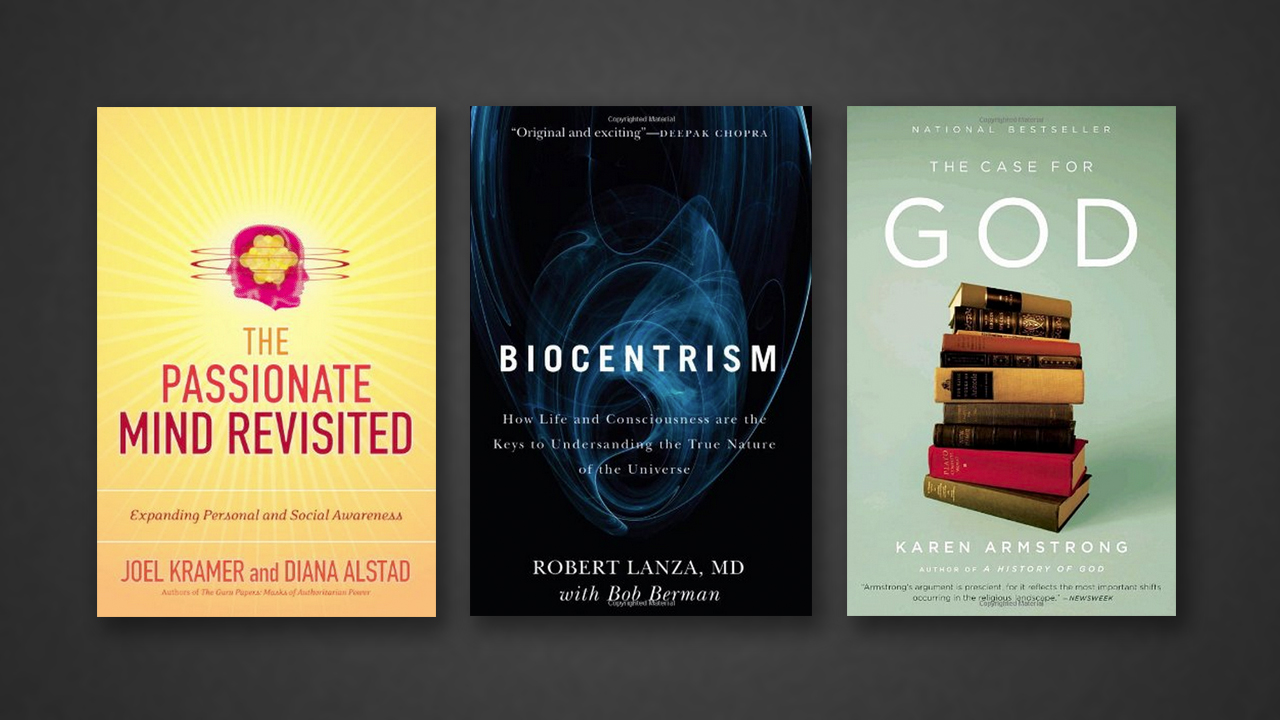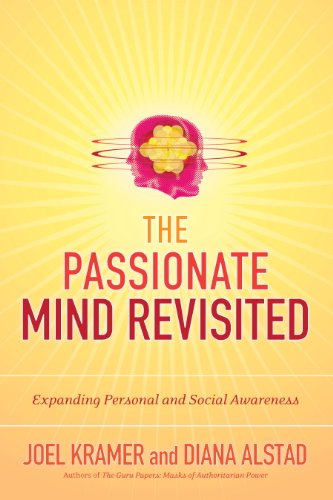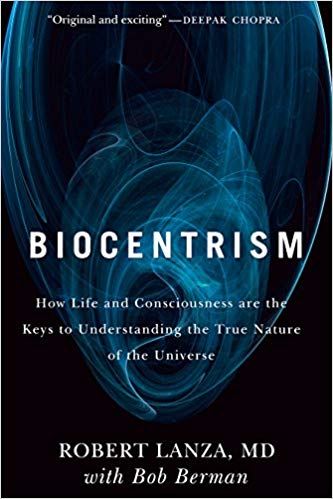Prove All Things
The Passionate Mind Revisited: Expanding Personal and Social Awareness
Joel Kramer and Diana Alstad. 2009. North Atlantic Books, Berkeley, California. 384 pages.
Biocentrism: How Life and Consciousness Are the Keys to Understanding the True Nature of the Universe
Robert Lanza, with Bob Berman. 2009. BenBella Books, Inc., Dallas, Texas. 224 pages.
The Case for God
Karen Armstrong. 2009. Random House, Albert A. Knopf, New York. 432 pages.
The purpose of human life is simply to find one’s own meaning and pursue it as a kind of personal crusade. So says British philosopher Julian Baggini, who cites Jesus’ statement—“I came that they may have life and have it abundantly” (John 10:10b, English Standard Version)—to help back up his claim. In Baggini’s view, Jesus was a messiah who granted us freedom to create our own purpose from within by releasing us from the bonds of archaic obedience. Guided by our own desires, without any sense that there are outside forces to consider in our decision-making, we must each decide for ourselves what it’s all about.
Three recent books speak to this view of human purpose and potential. Each provides food for thought on the problem of belief and how one constructs his arc of life. Whether from philosophy, science or religion, each book addresses transcendent questions of human existence. And while each offers insights into particular facets of our unique and compelling quest to discover transcendent purpose in the universe, they are incomplete—not only as single works but even in their collective message.
Revisiting One’s Beliefs
The overarching lesson of Joel Kramer and Diana Alstad’s The Passionate Mind Revisited is humility. At its core, humility requires that we examine ourselves and step back to change those things that we discover are amiss. Like Baggini, Kramer and Alstad find that this has nothing to do with a recognition of any kind of higher authority. To them, humility means that we must see ourselves as responsible only to ourselves. In fact, they write, we must free ourselves from broken dogmas—from the “authority of the past” and the “power hierarchy.” Only then will we be able to rectify the problems we face as a species.
As implied by the title, this is an expansion of Kramer’s The Passionate Mind (1974). There he asked the reader to become more introspective in accordance with the mantra of the time. Essentially a self-help book incorporating techniques of yoga and meditation, Kramer suggested that improved self-awareness at the individual level would bear fruit in the wider social realm.
Extending the argument today through Alstad’s updating of the wider humanitarian view, they note, “Our problems involve the nature and problems of being human, and unless there is a real change in people’s minds and hearts, there is no real change at all.” This is a true and useful message, and it forms the core of the new book. To insist, however, that meaningful change can occur without some reference point seems to be over-simplifying our condition. How does one weigh his options without some checkpoints?
The “revisiting” aspect of the new book is the clarification of self-interest in light of global challenges: we have been our own nemesis, trusting in our own wants for too long and overlooking the negative results of striving for those desires: “Sustainability cannot mean going back to a lesser life, but must offer an equal or better existence with more hope. And that can only mean connecting with each other more deeply and effectively as we engage in the human drama.” Thus, they argue, a healthy future for humanity pivots on the removal of the doctrines of separation, the beliefs and ideas that fragment people into competing subgroups. Specifically, it demands the removal of religion.
They keenly observe, “Ours is a sorrow-filled world of separate beliefs and identities competing with each other for supremacy.” Of course, they are correct. But they abuse the argument by insisting that it is religion itself—all religion, all belief—that fuels the drive for supremacy. A close reading of the Bible does not support such a claim. Surprisingly, not even the most fundamental concept of salvation, so widely expressed as a contest for souls between God and Satan, is biblically based.
Nevertheless, they are adamant: religion is little more than a system for “justifying beliefs.” Because they themselves believe human consciousness is the product of natural selection, they seek to show how conflict was a constructive force in the past. As a product of this struggle, they conclude, it is only natural that we find ourselves in a battle of extremes. Egotism and altruism; cooperation and competition; separation and unity; the One and the Many; merging and individuation; spiritual and material; control and surrender—all are indicative of natural conflicts within us. Myth and religion once served tribal groups as a means of transcendence. But today these outdated pre-science myths only exacerbate distrust and compel separation.
This has wide-ranging implications in a world that requires integrated solutions rather than piecemeal shimming-up of teetering political, economic and ecologic systems: “Worldviews that are fundamentally unchangeable, no matter what, are authoritarian and increasingly outmoded because they cannot cope with a rapidly changing and diversifying local and greater world.” There is no common ground possible when parties are immobilized, anchored at competing poles.
Further, they note, “faith is a subset of belief that values ignoring all evidence that contradicts the worldview” that individuals have established as their source of identity. Without a doubt, choosing to stubbornly stand firm in ways that are outwardly violent and blatantly aggressive is an identity from which one should flee.
The passionate mind, then, is the mind that seeks to know itself. It “involves the clarity to be in touch with ‘what is,’ including its possible implications.” A key aspect is just to look and observe rather than to judge and compare. The unexamined life is the problem, largely because it compounds into an unexamined world.
But in the view of these authors, we are not asking ourselves the right questions, having already been programmed with the wrong answers by preconditioned values, second-hand beliefs, outmoded worldviews, and ideas from the past absorbed especially during childhood. This, they argue, is not living in reality, a place where most all such beliefs are impossible. The authors are especially hard on beliefs that stymie one’s ability to accept change and to create new assessments of “what is.” They advocate a greater fluidity of mind, a mind better able to assess personal and collective connections and the causes and effects that arise from them, and a reevaluation of all things handed down to us in an unproven, second-hand fashion.
A Mind-Centric Universe
The bigger problem, suggest biologist Robert Lanza and astronomer Bob Berman in Biocentrism, may be that reality itself is a fluctuating construction. What if “what is” can be virtually anything that comes to mind?
They propose that the center of the human universe is the mind itself. All we know, feel, perceive and think exists only, so to speak, between our ears. And while physics may begin to explain the structure and history of the universe, “nothing in modern physics explains how a group of molecules in your brain create consciousness.” In fact, it isn’t doing too well with the universe either. Confusion seems to reign on all fronts: The problem “is so deep that virtually everyone knows that something is screwy with the way we visualize the cosmos.”
The authors outline biocentrism in seven principles. In summary, these suggest that our “animal-sense perception” requires that we have a feeling of time and space but that these are merely illusory; time and space do not really exist. All that exists is consciousness. Thus “the universe bursts into existence from life, not the other way around.”
Is there an objective universe, then? According to Lanza and Berman, the answer is a surprising no. “Reality is not ‘there’ with definite properties waiting to be discovered but actually comes into being depending upon the actions of the observer,” they write. And so the origin of the universe is not the big bang; it is the big observer-dependent argument. “Obviously, it is outside traditional physics to discover that these perpetual images that surround us so vividly are a construction, a finished product hovering inside the head.”
This, Lanza and Berman argue, is the ultimate meaning of quantum physics and the strange phenomenon of entanglement—the conclusion that subatomic particles know when they are being watched and can adjust their properties accordingly, even going back in time to do so: the existence of human consciousness now brings the universe into existence then.
“Our minds are so good at creating a three-dimensional universe that we rarely question whether the universe is anything other than we imagine it. . . . Sights, tactile experiences, odors—all these sensations are experienced inside the mind alone. None are ‘out there’ except by the convention of language. Everything we observe is the direct interaction of energy and mind. Anything that we do not observe directly exists only as potential—or more mathematically speaking—as a haze of probability.”
Berman is well known for his astronomy writing and in particular for focusing on aspects of the universe that are not well understood. Obviously biocentrism is far removed from standard explanations of the universe, but “if any of this seems too preposterous,” the authors remark, “just consider the alternative, which is what contemporary science asks us to believe: that the entire universe, exquisitely tailored for our existence, popped into existence out of absolute nothingness. Who in their right mind would accept such a thing?”
Having built his reputation on being a gadfly, Berman is willing to go out on an astronomical limb for effect, so one cannot be sure about how all-in he is here. The reader therefore turns the pages slowly, half expecting the next sentence to start with “Gotcha!”
Lanza, on the other hand, writes much more personally concerning his conclusions. His chapters emphasize human relationships. As a medical doctor, death has been a large part of his experience. He tells poignant stories of friends’ and family members’ fatal accidents, horrific mostly for their brevity. But biocentrism has offered him solace. “Our current scientific worldview offers no escape for those afraid of death,” he notes. “But why are you here now, perched seemingly by chance on the cutting edge of all infinity? The answer is simple—the door is never closed! The mathematical possibility of your consciousness ending is zero.”
God Is a Good Idea
Karen Armstrong might share some common ground with Lanza. “What lies behind or beyond the universe is inconceivable to us. When we try to think of its ‘Creator’ our minds simply seize up,” she writes in The Case for God. Kramer and Alstad might also find value in her latest book. She is not actually making a case for any real God at all—which they would consider an enlightened stance—but rather for thinking about the good things that the idea of God can inspire within any religion.
Both Lanza and Armstrong were raised Catholic. Apparently abandoning religion earlier in life than she did, Lanza recounts his experience as a child asking, “If, indeed, God had made the world, then who made God?” His response reveals his clouded sense of God and the banality of a religion that did not connect with his own sense of the universe.
Regarding the need for a shift of human perspective, Kramer and Alstad warn that we must become “very different from who we are, which has never worked.” Armstrong similarly asks us to think more deeply about our practices, why we do the things we do.
Assuring that she has “no intention of attacking anybody’s sincerely held beliefs,” Armstrong offers “to bring something fresh to the table,” in the hope of defusing the “contentious nature” of contemporary religious discussion. Though she admits that “the symbolism of the modern God works well” for many people, she nonetheless throws the whole array of modern criticisms toward deconstructing Him (just as she atomized the monotheistic religions in her History of God [1993]).
In some ways such a deconstruction is needed, as certainly much baggage has been piled on. From her own experience growing up in Catholicism and later in the seminary, Armstrong recognizes and admits the discontinuities between what she was taught and what is written in the Scriptures themselves. “We may have to unlearn a great deal about religion before we can move on to new insight,” she suggests.
As a “freelance monotheist,” she seems to be seeking the truth at the core of religion. But her commentary is decidedly one-sided. As she shows throughout her book, she is unconvinced that a true Creator God exists beyond human mythmaking—although she does not count herself among militant “Dawkinsesque” atheists. Armstrong reads the Scriptures like tea leaves to be interpreted or flung about into new configurations rather than as essential communication. The inevitable result is a God of what she calls “absolute ineffability.”
Armstrong may like the idea of God as a mysterious something that implies and motivates human charity, but her “case for God” is even less satisfying than the case that Lanza and Berman make for biocentrism. Religion, she writes, is simply a matter of “mythologies, rituals, and ethical disciplines.”
In some ways this is true. Because so much of what is considered “of God” today is a reflection of human invention and a decontextualization of Scripture, Armstrong’s confusion in untangling the Bible from the religions that have been spun out from it is not unexpected. And, as Kramer and Alstad instruct, it is these “second-hand” beliefs that must be abandoned. Unfortunately, Armstrong is of little help in sifting the wheat from the religious chaff.
She does praise those who have given their lives “intimations of holiness that seemed in some indescribable way to enhance and fulfill their humanity.” She concludes that “the point of religion was to live intensely and richly here and now.” Socrates, Jesus and Muhammad, she writes, “developed a spiritual capacity that took them beyond the norm and revealed to their followers the untapped ‘divine’ or ‘enlightened’ potential that exists in any man or woman.”
In the end, tapping into one’s human potential turns out to be her case for God. “Those who applied themselves most assiduously” to the higher ideals of generosity, justice and sincerity, she writes, “showed that it was possible for mortal men and women to live on a higher, divine, or godlike plane and thus wake up to their true selves.”
An Abundant Life
Largely because they recognized the flaws and shortcomings of traditional religion, the authors of these three books have rejected religious teaching. In their rejection of tradition they have also rejected the Bible, the presumed source of much religious tradition. But this itself is an error. Their common conclusion is therefore thoroughly humanistic: we humans hold our destiny in our own hands.
When one views the context of Jesus’ statement that humankind is to “have life and have it abundantly,” it becomes clear that His message was not one of abandoning the past. Nor was He suggesting that we have the wherewithal to invent human potential; rather, Jesus was an example to follow in terms of love toward God and man—a pattern of godliness to which all humanity is meant to attain. He exemplified the potential that was established at humankind’s creation. It is a potential that exceeds human imagination (1 Corinthians 2:9) and culminates in a face-to-face relationship with the Godhead (1 John 3:2–3; Revelation 21).
We would do well to study Christ’s example and follow it as our model for life. But to actually do so, to practice what one accepts as the right path, includes the willingness to acquiesce to the one laying out the path. In this these authors are correct: we must hear the message for ourselves; it must be a firsthand commitment.
The fact of human consciousness is a matter of spirit, not cells (1 Corinthians 2:11; Job 32:8). Our amazing capacities for creativity, foresight, love and questioning do not arise from the evolutionary process nor from unknown physical forces within the universe at large. The idea of biocentrism is rooted in a reality, although not the reality Lanza and Berman expound; physical reality is not the result of our perceptions bringing probabilities into focus. We and the universe are creations in the truest sense, ideas born in the mind of a Creator, a personal God who invented us in order to fill a renewed heaven and earth with beings sharing His character (see Psalm 8; Hebrews 8; Revelation 21). This is not the god molded of human history, the god Armstrong suggests we tame and domesticate.
The fullness of our potential can only be understood when mixed with a measure of trust and faith—faith first and foremost to listen to the shepherding voice that says, Yes, there is a purpose beyond what we can sense or conjure from within our minds alone.
The conclusions these authors reach, however dexterous and intricate, therefore remain unsatisfying. From very different perspectives each has correctly sensed the need for new modes of seeing the world and our place in it. But, as they suggest, a major shift in perceiving who we are and what we are meant to be is very difficult. We are individually and collectively burdened with many second-hand teachings. These distract us from proving and accepting the simplicity of the message.
Conversion of thought does occur, however, one mind at a time. It begins with our individual willingness to reflect on our own experience, vision and hope.




